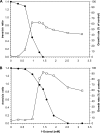Adaptation of the hydrocarbonoclastic bacterium Alcanivorax borkumensis SK2 to alkanes and toxic organic compounds: a physiological and transcriptomic approach
- PMID: 23645199
- PMCID: PMC3697512
- DOI: 10.1128/AEM.00694-13
Adaptation of the hydrocarbonoclastic bacterium Alcanivorax borkumensis SK2 to alkanes and toxic organic compounds: a physiological and transcriptomic approach
Abstract
The marine hydrocarbonoclastic bacterium Alcanivorax borkumensis is able to degrade mixtures of n-alkanes as they occur in marine oil spills. However, investigations of growth behavior and physiology of these bacteria when cultivated with n-alkanes of different chain lengths (C6 to C30) as the substrates are still lacking. Growth rates increased with increasing alkane chain length up to a maximum between C12 and C19, with no evident difference between even- and odd-numbered chain lengths, before decreasing with chain lengths greater than C19. Surface hydrophobicity of alkane-grown cells, assessed by determination of the water contact angles, showed a similar pattern, with maximum values associated with growth rates on alkanes with chain lengths between C11 and C19 and significantly lower values for cells grown on pyruvate. A. borkumensis was found to incorporate and modify the fatty acid intermediates generated by the corresponding n-alkane degradation pathway. Cells grown on distinct n-alkanes proved that A. borkumensis is able to not only incorporate but also modify fatty acid intermediates derived from the alkane degradation pathway. Comparing cells grown on pyruvate with those cultivated on hexadecane in terms of their tolerance toward two groups of toxic organic compounds, chlorophenols and alkanols, representing intensely studied organic compounds, revealed similar tolerances toward chlorophenols, whereas the toxicities of different n-alkanols were significantly reduced when hexadecane was used as a carbon source. As one adaptive mechanism of A. borkumensis to these toxic organic solvents, the activity of cis-trans isomerization of unsaturated fatty acids was proven. These findings could be verified by a detailed transcriptomic comparison between cultures grown on hexadecane and pyruvate and including solvent stress caused by the addition of 1-octanol as the most toxic intermediate of n-alkane degradation.
Figures







Similar articles
-
Membrane Fatty Acid Composition and Cell Surface Hydrophobicity of Marine Hydrocarbonoclastic Alcanivorax borkumensis SK2 Grown on Diesel, Biodiesel and Rapeseed Oil as Carbon Sources.Molecules. 2018 Jun 13;23(6):1432. doi: 10.3390/molecules23061432. Molecules. 2018. PMID: 29899233 Free PMC article.
-
Transcriptional profiling of the marine oil-degrading bacterium Alcanivorax borkumensis during growth on n-alkanes.FEMS Microbiol Lett. 2011 Jun;319(2):160-8. doi: 10.1111/j.1574-6968.2011.02279.x. Epub 2011 Apr 20. FEMS Microbiol Lett. 2011. PMID: 21470299
-
The Glycine-Glucolipid of Alcanivorax borkumensis Is Resident to the Bacterial Cell Wall.Appl Environ Microbiol. 2022 Aug 23;88(16):e0112622. doi: 10.1128/aem.01126-22. Epub 2022 Aug 8. Appl Environ Microbiol. 2022. PMID: 35938787 Free PMC article.
-
Occurrence, production, and export of lipophilic compounds by hydrocarbonoclastic marine bacteria and their potential use to produce bulk chemicals from hydrocarbons.Appl Microbiol Biotechnol. 2010 May;86(6):1693-706. doi: 10.1007/s00253-010-2515-5. Epub 2010 Mar 31. Appl Microbiol Biotechnol. 2010. PMID: 20354694 Review.
-
Occurrence of n-Alkanes in Vegetable Oils and Their Analytical Determination.Foods. 2020 Oct 26;9(11):1546. doi: 10.3390/foods9111546. Foods. 2020. PMID: 33114601 Free PMC article. Review.
Cited by
-
Hexadecane and pristane degradation potential at the level of the aquifer--evidence from sediment incubations compared to in situ microcosms.Environ Sci Pollut Res Int. 2014;21(15):9081-94. doi: 10.1007/s11356-014-2601-9. Epub 2014 Feb 14. Environ Sci Pollut Res Int. 2014. PMID: 24522398
-
New family of biosensors for monitoring BTX in aquatic and edaphic environments.Microb Biotechnol. 2016 Nov;9(6):858-867. doi: 10.1111/1751-7915.12394. Epub 2016 Aug 3. Microb Biotechnol. 2016. PMID: 27484951 Free PMC article.
-
Quantitative insights into the efficacy of genome-resolved surveys of microbial communities through ribosomal protein phylogeography and EcoPhylo.bioRxiv [Preprint]. 2025 Apr 23:2025.01.15.633187. doi: 10.1101/2025.01.15.633187. bioRxiv. 2025. PMID: 39868213 Free PMC article. Preprint.
-
Dispersant Enhances Hydrocarbon Degradation and Alters the Structure of Metabolically Active Microbial Communities in Shallow Seawater From the Northeastern Gulf of Mexico.Front Microbiol. 2019 Oct 18;10:2387. doi: 10.3389/fmicb.2019.02387. eCollection 2019. Front Microbiol. 2019. PMID: 31749769 Free PMC article.
-
Insights into the Potential of the Atlantic Cod Gut Microbiome as Biomarker of Oil Contamination in the Marine Environment.Microorganisms. 2019 Jul 22;7(7):209. doi: 10.3390/microorganisms7070209. Microorganisms. 2019. PMID: 31336609 Free PMC article.
References
-
- Golyshin PN, Dos Santos V, Kaiser O, Ferrer M, Sabirova YS, Lunsdorf H, Chernikova TN, Golyshina OV, Yakimov MM, Puhler A, Timmis KN. 2003. Genome sequence completed of Alcanivorax borkumensis, a hydrocarbon-degrading bacterium that plays a global role in oil removal from marine systems. J. Biotechnol. 106:215–220 - PubMed
-
- Schneiker S, dos Santos V, Bartels D, Bekel T, Brecht M, Buhrmester J, Chernikova TN, Denaro R, Ferrer M, Gertler C, Goesmann A, Golyshina OV, Kaminski F, Khachane AN, Lang S, Linke B, McHardy AC, Meyer F, Nechitaylo T, Puhler A, Regenhardt D, Rupp O, Sabirova JS, Selbitschka W, Yakimov MM, Timmis KN, Vorholter FJ, Weidner S, Kaiser O, Golyshin PN. 2006. Genome sequence of the ubiquitous hydrocarbon-degrading marine bacterium Alcanivorax borkumensis. Nat. Biotechnol. 24:997–1004 - PMC - PubMed
-
- Yakimov MM, Timmis KN, Golyshin PN. 2007. Obligate oil-degrading marine bacteria. Curr. Opin. Biotechnol. 18:257–266 - PubMed
-
- Hara A, Baik S, Syutsubo K, Misawa N, Smits THM, van Beilen JB, Harayama S. 2004. Cloning and functional analysis of alkB genes in Alcanivorax borkumensis SK2. Environ. Microbiol. 6:191–197 - PubMed
Publication types
MeSH terms
Substances
Associated data
- Actions
LinkOut - more resources
Full Text Sources
Other Literature Sources
Molecular Biology Databases
Research Materials

